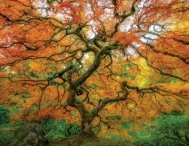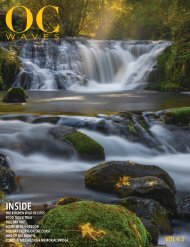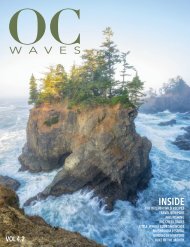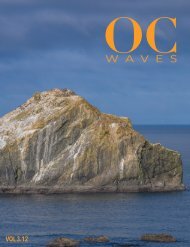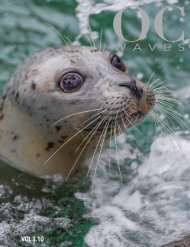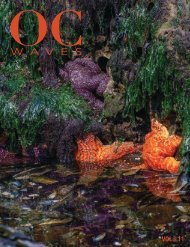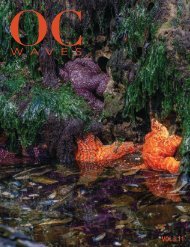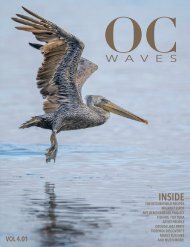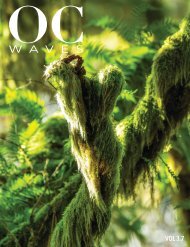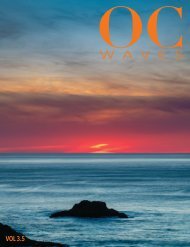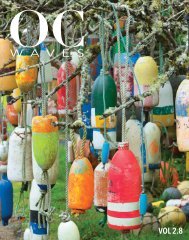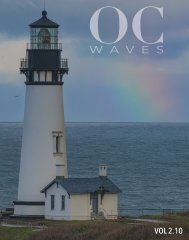OC Waves Vol 3.6
Premium monthly magazine serving the Oregon coast
Premium monthly magazine serving the Oregon coast
Create successful ePaper yourself
Turn your PDF publications into a flip-book with our unique Google optimized e-Paper software.
small mesh size to sample without destroying<br />
the gelatinous bodies of the jellies. A ring net,<br />
aptly named for its ring-shaped opening, is also<br />
deployed to collect even smaller zooplankton.<br />
On those mornings that I was running late, my<br />
saving grace was that sampling can be described<br />
as a “hurry up and wait” kind of process on the<br />
Langseth. When M<strong>OC</strong>NESS was sent over the<br />
side of the ship, it took around 30 minutes to<br />
reach the sea floor and return to the ship’s deck.<br />
Then there was a burst of action as samples<br />
were hauled into the lab for processing. A net’s<br />
contents were poured into clear glass casserole<br />
dishes with lights housed below, illuminating<br />
the collection of organisms as scientists crowded<br />
around to point out interesting specimens worthy<br />
of being photographed or bountiful enough to<br />
be sent for elemental analysis. It is within these<br />
casserole dishes that I began to see the tiny world<br />
of gelatinous zooplankton.<br />
Gelatinous zooplankton come in a range of<br />
shapes, sizes and behaviors. Some are round and<br />
flat and look like ornate or fine china. Others are<br />
long and skinny with many leg-like protrusions,<br />
which allow them to swim incredibly fast. Among<br />
all these unique animals, there was one group that<br />
captured the attention of the entire science party<br />
and crew.<br />
The gelatinous zooplankton the Sutherland Lab is interested in are small, but in the words of Dr. Terra Hiebert, “…<br />
just because something is difficult to see doesn’t mean that it isn’t extremely relevant in many ways.”<br />
Most zooplankton are translucent, with some<br />
tan or yellow organs, but Doliolids stand out due<br />
to their colorful purple banding. A single barrelshaped<br />
Doliolid doesn’t have enough pigment to<br />
really be that interesting, but in mass aggregations<br />
of thousands of individuals, they produce a<br />
vibrant plum color.<br />
Doliolids weren’t collected at every site, but they<br />
could consistently be found at sites over 50 miles<br />
offshore. Where they were found, they were the<br />
most abundant gelatinous zooplankton, and their<br />
purple hue indicated their abundance in the ring<br />
net long before it was poured into our dishes.<br />
Despite their eye-catching appearance, Doliolids<br />
aren’t well known by most marine scientists<br />
or general audiences. While they haven’t been<br />
extensively studied, limited, existing literature<br />
suggests that warming sea temperatures will<br />
promote Doliolid populations to bloom due to<br />
the increase in their food source, phytoplankton.<br />
Understanding how different conditions may<br />
impact zooplankton composition is central to<br />
the work being done by the Sutherland Lab.<br />
All sampling was done in combination with an<br />
instrument that collects information on the water’s<br />
salinity and temperature at different depths. This<br />
helps researchers see patterns in the distribution<br />
of specific zooplankton, and while some trends are<br />
noticed during sampling, like where Doliolids can<br />
be found, most of the work is done back on land.<br />
Kevin Du Clos (left) and Alejandro Damian Serrano guide the ring net full of diatoms (dark substance) back on<br />
deck. Diatoms are single-celled algae that make samples denser and more difficult to filter and sort through.<br />
eager to get back to their families and also into<br />
the lab to start processing the data collected<br />
from all 28 sites sampled. Processing will take a<br />
couple years, and the sampling isn’t done there.<br />
This winter, the Sutherland Lab will again be out<br />
at sea to introduce another factor, seasonality,<br />
to their research. By overlaying ocean conditions<br />
and seasonality onto sampling data, the lab<br />
hopes to create predictive models of zooplankton<br />
composition in response to climate change.<br />
While climate change continues to impact our<br />
marine ecosystems, the types of organisms you<br />
find washed up on our beaches will likely change.<br />
Most people who walk along beaches will usually<br />
find an assortment of jellies, like pacific sea nettles<br />
or comb jellies, but Doliolids aren’t often found<br />
washed ashore. When Doliolids do find their way<br />
to land, it is in masses.<br />
beachgoers may start to see more of these purpledbanded,<br />
barrel-shaped organisms, something that<br />
previously seemed unattainable unless you found<br />
yourself abroad a ship collecting zooplankton.<br />
While these purple jellies are fascinating to<br />
observe, these blooms are also a cue to what is<br />
happening in the environment. There are changes<br />
occurring to our marine ecosystems, and this is<br />
one obvious indication of that.<br />
The Sutherland Lab’s goal of creating<br />
zooplankton composition models will take a couple<br />
years, and our understanding of how increasing<br />
Doliolid populations may affect the larger food<br />
web will take even longer. For now, next time they<br />
start to wash up on Oregon beaches, take some<br />
time to investigate their tiny world and appreciate<br />
gelatinous zooplankton at their most colorful. I<br />
know I will be.<br />
After two weeks at sea, the science party was<br />
As these blooms become more common,<br />
BY CARMEN SANCHEZ-REDDICK<br />
<strong>OC</strong> WAVES • VOL <strong>3.6</strong><br />
31



